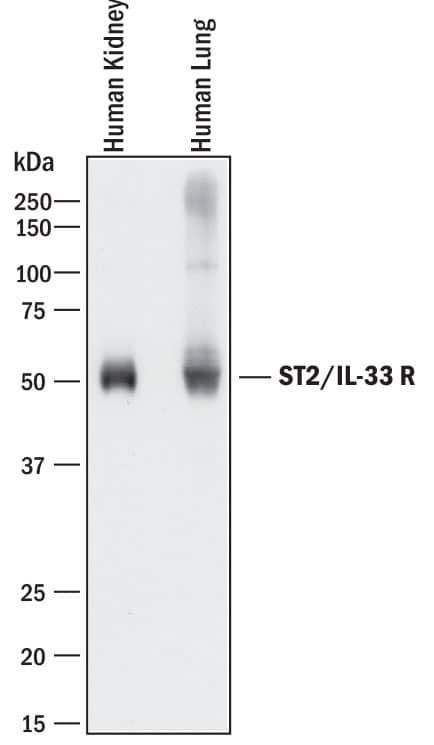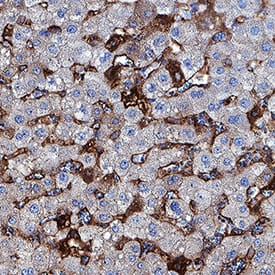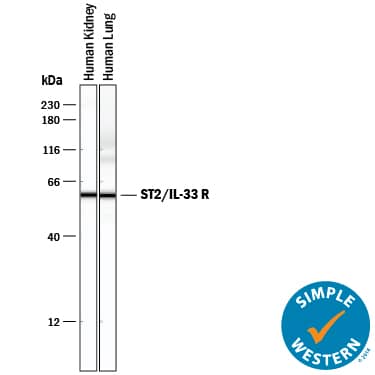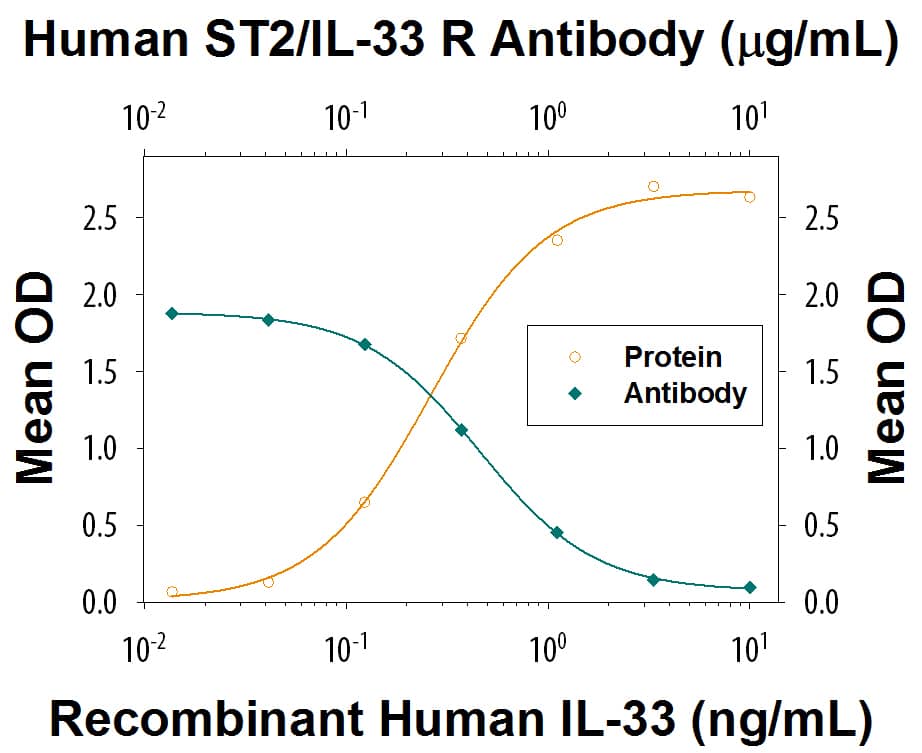Human ST2/IL-33R Antibody
R&D Systems, part of Bio-Techne | Catalog # AF523


Key Product Details
Species Reactivity
Validated:
Human
Cited:
Human, Mouse
Applications
Validated:
Immunohistochemistry, Neutralization, Simple Western, Western Blot
Cited:
Cell Culture, Immunohistochemistry, Immunohistochemistry-Frozen, Immunohistochemistry-Paraffin, Immunoprecipitation, Neutralization, Western Blot
Label
Unconjugated
Antibody Source
Polyclonal Goat IgG
Product Specifications
Immunogen
S. frugiperda insect ovarian cell line Sf 21-derived recombinant human ST2/IL-33 R
Lys19-Phe328
Accession # BAA02233
Lys19-Phe328
Accession # BAA02233
Specificity
Detects human ST2/IL-33 R in direct ELISAs and Western blots.
Clonality
Polyclonal
Host
Goat
Isotype
IgG
Endotoxin Level
<0.10 EU per 1 μg of the antibody by the LAL method.
Scientific Data Images for Human ST2/IL-33R Antibody
Detection of Human ST2/IL-33 R by Western Blot.
Western blot shows lysates of human kidney tissue and human lung tissue. PVDF membrane was probed with 0.2 µg/mL of Goat Anti-Human ST2/IL-33 R Antigen Affinity-purified Polyclonal Antibody (Catalog # AF523) followed by HRP-conjugated Anti-Goat IgG Secondary Antibody (HAF017). A specific band was detected for ST2/IL-33 R at approximately 50 kDa (as indicated). This experiment was conducted under reducing conditions and using Immunoblot Buffer Group 1.ST2/IL-33 R in Human Liver.
ST2/IL-33 R was detected in immersion fixed paraffin-embedded sections of human liver using Goat Anti-Human ST2/IL-33 R Antigen Affinity-purified Polyclonal Antibody (Catalog # AF523) at 1.7 µg/mL for 1 hour at room temperature followed by incubation with the Anti-Goat IgG VisUCyte™ HRP Polymer Antibody (Catalog # (VC004). Before incubation with the primary antibody, tissue was subjected to heat-induced epitope retrieval using Antigen Retrieval Reagent-Basic (CTS013). Tissue was stained using DAB (brown) and counterstained with hematoxylin (blue). Specific staining was localized to cell membranes. View our protocol for IHC Staining with VisUCyte HRP Polymer Detection Reagents.Detection of Human ST2/IL-33 R by Simple WesternTM.
Simple Western lane view shows lysates of human kidney tissue and human lung tissue, loaded at 0.2 mg/mL. A specific band was detected for ST2/IL-33 R at approximately 60 kDa (as indicated) using 2 µg/mL of Goat Anti-Human ST2/IL-33 R Antigen Affinity-purified Polyclonal Antibody (Catalog # AF523) followed by 1:50 dilution of HRP-conjugated Anti-Goat IgG Secondary Antibody (HAF109). This experiment was conducted under reducing conditions and using the 12-230 kDa separation system.Applications for Human ST2/IL-33R Antibody
Application
Recommended Usage
Immunohistochemistry
1-15 µg/mL
Sample: Immersion fixed paraffin-embedded sections of human liver
Sample: Immersion fixed paraffin-embedded sections of human liver
Simple Western
2 µg/mL
Sample: Human kidney tissue and human lung tissue
Sample: Human kidney tissue and human lung tissue
Western Blot
0.2 µg/mL
Sample: Human kidney tissue and human lung tissue
Sample: Human kidney tissue and human lung tissue
Neutralization
Measured by its ability to neutralize IL‑33-induced IFN-gamma secretion in Human Peripheral Blood Mononuclear cells (PBMC). Blom, L and Poulsen, LK (2012) JI 189:4331. The Neutralization Dose (ND50) is typically 0.1-0.6 μg/mL in the presence of 1 ng/mL Recombinant Human IL‑33.
Reviewed Applications
Read 1 review rated 5 using AF523 in the following applications:
Formulation, Preparation, and Storage
Purification
Antigen Affinity-purified
Reconstitution
Reconstitute at 0.2 mg/mL in sterile PBS. For liquid material, refer to CoA for concentration.
Formulation
Lyophilized from a 0.2 μm filtered solution in PBS with Trehalose. See Certificate of Analysis for details.
*Small pack size (-SP) is supplied either lyophilized or as a 0.2 µm filtered solution in PBS.
*Small pack size (-SP) is supplied either lyophilized or as a 0.2 µm filtered solution in PBS.
Shipping
Lyophilized product is shipped at ambient temperature. Liquid small pack size (-SP) is shipped with polar packs. Upon receipt, store immediately at the temperature recommended below.
Stability & Storage
Use a manual defrost freezer and avoid repeated freeze-thaw cycles.
- 12 months from date of receipt, -20 to -70 °C as supplied.
- 1 month, 2 to 8 °C under sterile conditions after reconstitution.
- 6 months, -20 to -70 °C under sterile conditions after reconstitution.
Background: ST2/IL-33R
References
-
Barksby, H.E. et al. (2007) Clin. Exp. Immunol. 149:217.
-
Gadina, M. and C.A. Jefferies (2007) Science STKE 2007:pe31.
-
Tominaga, S. et al. (1992) Biochim. Biophys. Acta 1171:215.
-
Li, H. et al. (2000) Genomics 67:284.
-
Schmitz, J. et al. (2005) Immunity 23:479.
-
Lecart, S. et al. (2002) Eur. J. Immunol. 32:2979.
-
Brint, E.K. et al. (2004) Nat. Immunol. 5:373.
-
Weinberg, E.O. et al. (2002) Circulation 106:2961.
-
Sanada S. et al. (2007) J. Clin. Invest. 117:1538.
-
Palmer, G. et al. (2008) Cytokine 42:358.
-
Chackerian, A.A. et al. (2007) J. Immunol. 179:2551.
-
Allakhverdi, Z. et al. (2007) J. Immunol. 179:2051.
-
Verri Jr., W.A. et al. (2008) Proc. Natl. Acad. Sci. 105:2723.
-
Miller, A.M. et al. (2008) J. Exp. Med. 205:339.
-
Hayakawa, H. et al. (2007) J. Biol. Chem. 282:26369.
Long Name
Interleukin 33 Receptor
Alternate Names
DER4, Fit-1, IL-1 R4, IL-1R4, IL-1RL1, IL-33 R, IL-33R, IL1R4, IL33R, Ly84, ST2L, ST2V, T1
Gene Symbol
IL1RL1
UniProt
Additional ST2/IL-33R Products
Product Documents for Human ST2/IL-33R Antibody
Product Specific Notices for Human ST2/IL-33R Antibody
For research use only
